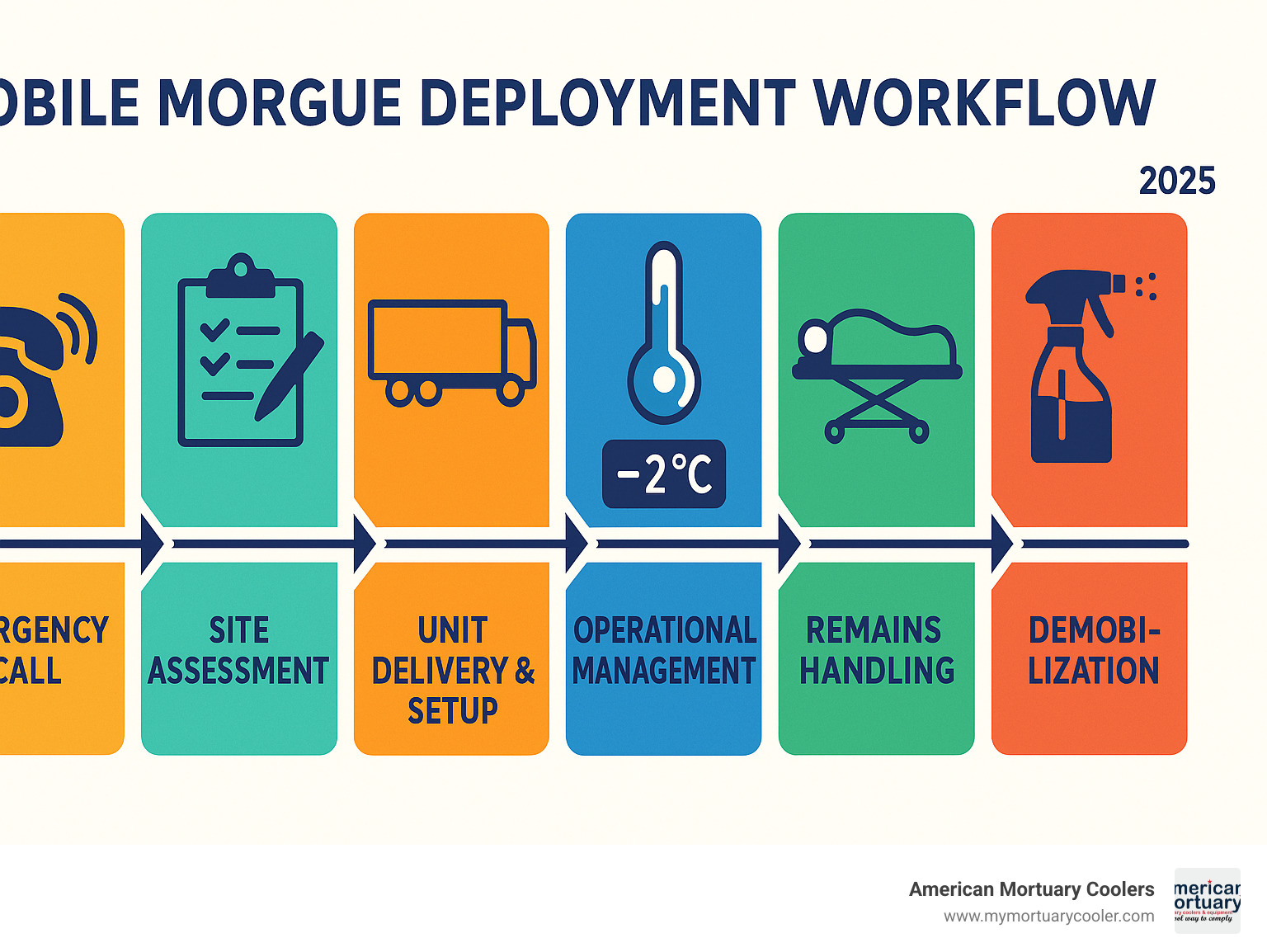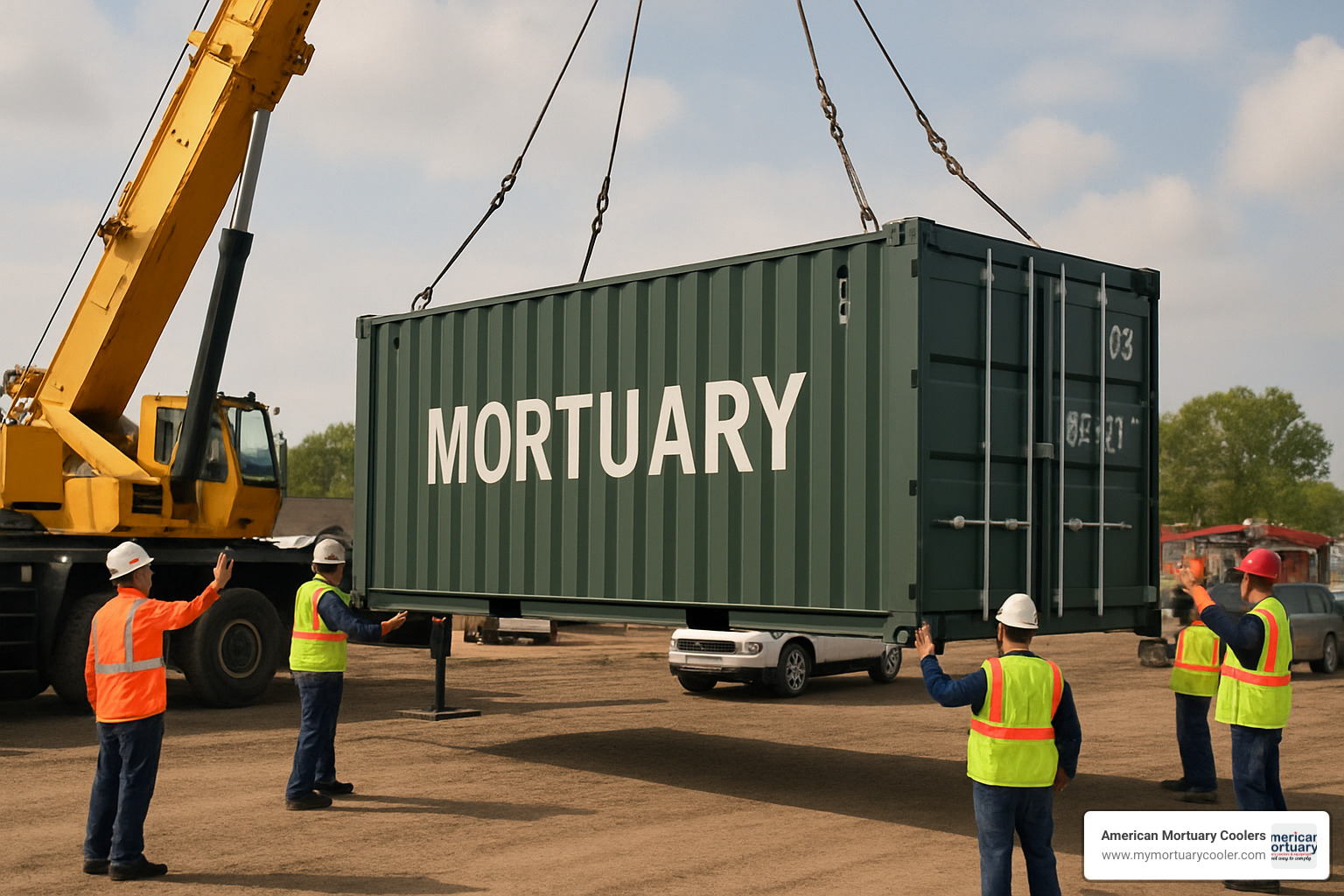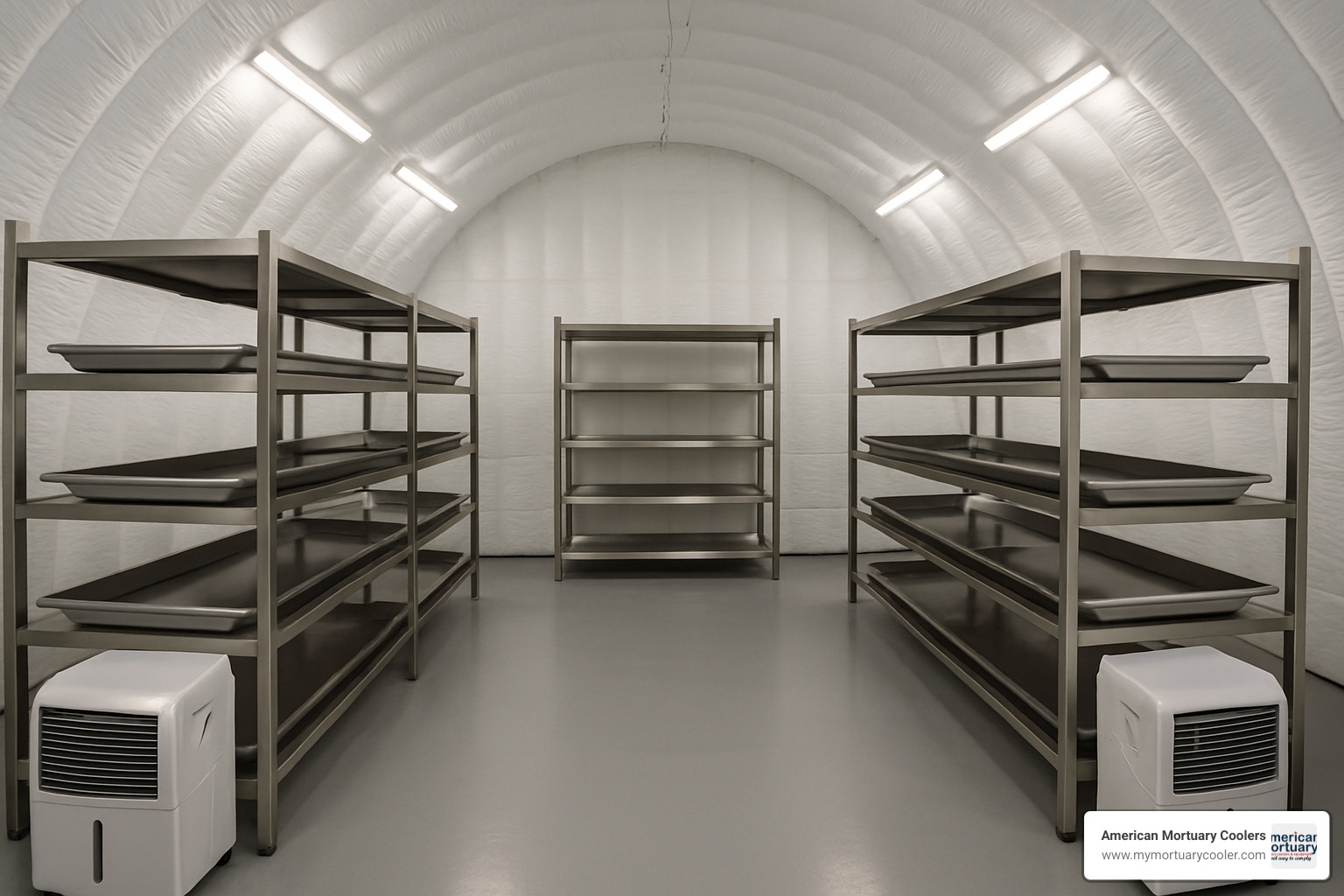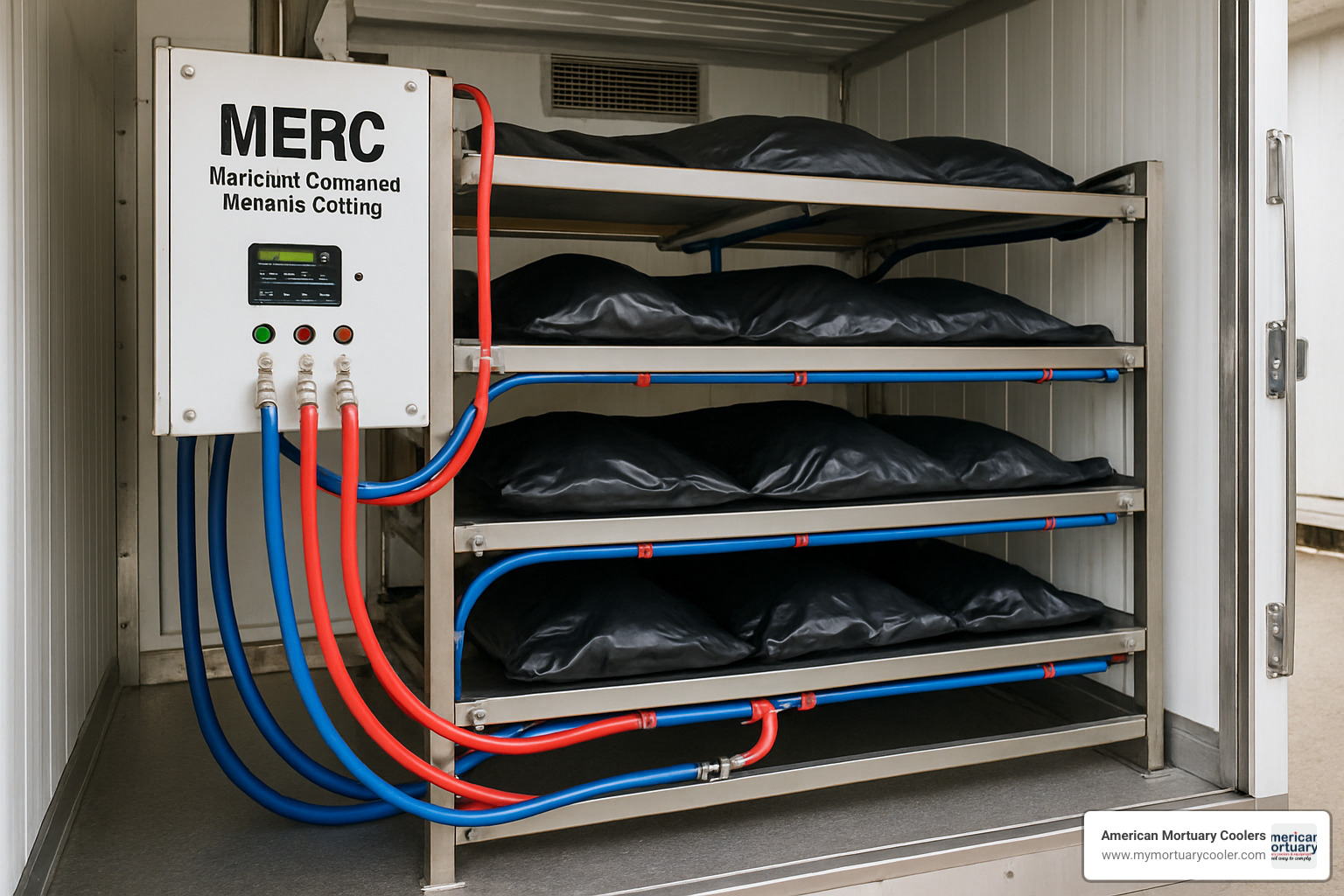Why Mobile Morgues Are Critical for Emergency Preparedness
Mobile morgues are portable refrigerated facilities designed to provide temporary body storage when local morgue capacity is overwhelmed during mass fatality events, pandemics, or disasters. These deployable units range from refrigerated trailers to inflatable domes, offering surge capacity that can be rapidly deployed to maintain dignified handling of the deceased while protecting public health.
Key Mobile Morgue Solutions:
- Refrigerated Trailers: 16-90 body capacity, 17-53 foot sizes, plug-and-play setup
- ISO Container Mortuaries: Up to 60 bodies per 20'/40' unit, modular layouts
- Inflatable Domes: 56-200+ body capacity, 20-minute setup time
- Portable Cooling Systems: Direct-contact liquid cooling, collapsible racks
The need for mobile morgues has become increasingly apparent. During COVID-19, New York City deployed 45 mobile morgues to handle the surge in deaths, while Thailand used 100 refrigerated trailers to store approximately 3,600 bodies after the 2004 tsunami.
These units maintain temperatures between 1°C and 5°C to slow decomposition and prevent disease transmission. Setup times vary from plug-and-play trailers to 20-minute inflatable dome deployment, with capacities ranging from 8 bodies in compact units to over 200 in expandable dome systems.
I'm Mortuary Cooler, a national-level mortuary cooler supplier with extensive experience helping funeral homes and emergency agencies plan for surge capacity using mobile morgues and related refrigeration solutions.

Similar topics to mobile morgues:
- bioseal body bags
- morgue trucks
- etymology of autopsy
Understanding Mobile Morgues
When tragedy strikes and the number of deceased overwhelms local facilities, mobile morgues step in as essential temporary solutions. These deployable units provide surge capacity while maintaining dignified handling that every family deserves during difficult circumstances.
These units do far more than simply store bodies. They represent a critical lifeline for communities facing mass fatality events, ensuring that proper standards for deceased care never falter. Scientific research on refrigerated trailers and disease control confirms their vital role in preventing decomposition and protecting survivors and first responders from potential health risks.
Mobile morgues serve emergency response by providing immediate surge capacity during disasters, maintaining proper refrigeration to preserve dignity, ensuring respectful treatment of the deceased, supporting public health through containment, and enabling proper identification workflows.
What Sets Mobile Morgues Apart from Fixed Facilities
The advantage of mobile morgues lies in their ability to bring professional-grade cooling directly to where it's needed most. While traditional morgue facilities remain anchored in one location, these units offer cooling on wheels that can respond to crises anywhere.
Modular storage design makes these units incredibly adaptable. Collapsible racks can be assembled with just a few bolts, or modular layouts that transform based on operational needs. This flexibility means each unit can adapt to different circumstances rather than forcing circumstances to fit the equipment.
Rapid deployment capabilities truly set mobile units apart. While constructing a permanent morgue facility takes months or years, mobile morgues can be operational within hours. Some inflatable dome systems achieve full deployment in just 20 minutes, while refrigerated trailers often need only an electrical connection.
Modern temperature control systems maintain precise ranges between -2°C and +5°C, matching or exceeding many permanent facilities. Advanced units feature digital monitoring, backup power systems, and alarm notifications to ensure consistent cooling performance.
Scalable capacity offers perhaps the greatest advantage. When one unit isn't enough, emergency responders can deploy additional mobile morgues to meet actual demand rather than being limited by permanent infrastructure.
When Are Mobile Morgues Deployed?
The scenarios requiring mobile morgues have expanded dramatically in recent years, reflecting both changing threats and improved emergency preparedness understanding.
Pandemic response thrust mobile morgues into the spotlight during COVID-19. New York City's deployment of 45 new mobile morgues during the crisis's peak showed how quickly even major metropolitan morgue systems can be overwhelmed.
Natural disasters create some of the most challenging fatality management scenarios. The 2004 Asian tsunami demonstrated this reality starkly—with over 200,000 deaths, Thailand alone organized 100 refrigerated trailers to provide storage for approximately 3,600 bodies.
Mass casualty events continue increasing according to emergency management data. Whether it's terrorist attacks, multi-vehicle crashes, train collisions, mass shootings, wildfires, or tornadoes, each scenario can quickly exceed local morgue capacity.
Rural overflow situations represent a growing deployment category. Smaller communities often operate with minimal morgue capacity under normal circumstances. During events like the opioid epidemic or severe flu seasons, even modest increases in fatalities can overwhelm local facilities.
Comparing Mobile Morgue Solutions
When it comes to mobile morgues, you've got several solid options to choose from. Each type brings its own strengths to the table, and understanding these differences can make all the difference when you're planning for the unexpected.
| Solution Type | Setup Time | Capacity | Power Requirements | Relative Cost | Best For |
|---|---|---|---|---|---|
| Refrigerated Trailers | Plug-and-play | 16-90 bodies | 120V-480V | Low-Medium | Immediate deployment, known capacity needs |
| ISO Container Mortuaries | 2-4 hours | Up to 60 bodies | 380V/3/50Hz | Medium | Medium-term deployment, modular expansion |
| Inflatable Domes | 20 minutes | 56-200+ bodies | Portable AC units | Medium-High | Large-scale events, rapid expansion needed |
| Portable Cooling Systems | 30 minutes | 8-48 bodies | 120V/15A | Low | Small-scale overflow, temporary needs |

The beauty of modern mobile morgues lies in their scalability. You can start with a single trailer for routine needs, then add ISO containers for medium-term situations, or deploy inflatable domes when you need serious capacity fast. Many emergency planners mix and match these solutions to create a comprehensive response capability.
Refrigerated Trailers & Reefer Trucks – the Workhorse Option
If mobile morgues had a MVP award, refrigerated trailers would win it hands down. These reefer trailers are the workhorses of emergency response, and there's a simple reason why they're deployed more than any other option: they just work.
The capacity range is impressive. You can get compact 17-foot units that hold 16 bodies, perfect for smaller communities or routine overflow situations. On the other end, massive 53-foot trailers can store up to 90 remains with specialized racking systems. Most facilities find the sweet spot somewhere in between, with 31-foot trailers accommodating around 48 bodies.
What makes these units so reliable is their straightforward operation. Modern morgue trailers maintain a steady 35°F (1°C) internal temperature even when it's blazing hot outside at 110°F. They come equipped with heavy-duty insulation and seamless flooring that makes cleanup straightforward, plus motion-sensing LED lights that conserve power when nobody's inside.
The plug-and-play nature is what really sets trailers apart. Most units need only an electrical connection to start working. Add in generator backup systems for power outages, rear ramps rated for 1,500 pounds for easy loading, and stainless steel racking with multiple configurations, and you've got a complete solution ready to go.
You can find detailed specifications and applications in our guide about reefer basics.
ISO Container Mortuaries for Medium-Term Storage
ISO container mortuaries occupy that sweet spot between simple trailers and complex dome systems. These purpose-built units bring serious capacity with the durability needed for longer deployments, making them ideal when you know you'll need mobile morgues for weeks or months rather than days.
The standard 20-foot and 40-foot container sizes can store up to 60 deceased per unit, which is substantial capacity in a relatively compact footprint. Dual-zone layouts are another standout feature. You can set different temperature zones within the same container, which is helpful when you need varying conditions for different operational needs.
The setup process takes 2-4 hours including crane positioning, which is longer than trailers but still quite reasonable. Once positioned, these containers provide robust long-term operation with fully contained cooling plants, stainless steel interior construction for durability, and customizable internal layouts.
Inflatable Domes & Shelter Systems
Inflatable dome systems represent the most innovative approach to mobile morgues, combining lightning-fast deployment with impressive capacity. These systems have revolutionized how we think about rapid response.
The 20-minute setup time is genuinely remarkable. From arrival on site to fully operational, these domes can be inflated and ready to accept remains in less time than it takes to properly position most other systems.

Base dome units typically accommodate 56 bodies in a 7m x 6m footprint, but the modular design allows you to connect additional domes, scaling capacity to over 200 bodies as needed. This expandability is unprecedented in mobile morgue solutions.
The captive air cooling technology is what makes rapid deployment possible. Unlike traditional systems requiring constant air supply, these domes seal once inflated. Portable air conditioning units maintain proper temperatures without the complexity of permanent cooling infrastructure.
Deploying & Operating Mobile Morgues
Getting mobile morgues up and running effectively requires more than just dropping a trailer in place and plugging it in. While these systems are designed for rapid deployment, proper planning makes the difference between a smooth operation and a stressful scramble during already difficult circumstances.
The site survey is your foundation for success. Before any equipment arrives, someone needs to walk the proposed location and check the basics. Power availability is often the biggest surprise - what looks like adequate electrical service might not handle the demands of refrigeration equipment. Mobile morgues need everything from standard 120V outlets for smaller portable units to heavy-duty 480V three-phase connections for large trailer systems.
Generator placement deserves special attention since backup power isn't optional in this work. You'll need clear access routes for fuel delivery trucks and enough clearance around the generator for safe operation and maintenance.
Forklift and ramp access might seem obvious, but it's surprising how often delivery gets complicated by overhead obstacles, narrow gates, or soft ground conditions. The operational workflow needs space too - areas for staff to work safely, secure perimeters for privacy and security, and proper drainage for cleaning and decontamination activities.
For detailed guidance on selecting and operating different types of mobile systems, check out our practical guide to morgue truck options.
Speed of Setup and Tear-Down
The beauty of modern mobile morgues lies in how quickly they can go from transport mode to fully operational. But "quick" means different things depending on which type of system you're deploying.
Inflatable dome systems are the speed champions, going from deflated to operational in about 20 minutes. Refrigerated trailers offer the most straightforward deployment. Most are essentially plug-and-play operations requiring only electrical connection to begin cooling.
MERC rack systems strike a nice balance with their 8-bolt assembly design. These collapsible racks can be set up in about 30 minutes without requiring specialized tools or extensive training. The PMEC portable units deploy even faster, designed for 30-minute setup with no tools required at all.
ISO container mortuaries require the most patience, needing crane positioning and several hours for complete setup. But once in place, they provide robust, long-term operational capability that justifies the extra deployment time.
Logistical Checklists for Mobile Morgues
Running effective mobile morgue operations means having systems in place before you need them. Emergency situations aren't the time to figure out who's responsible for what or where critical supplies are located.
Location clearance should happen early in the planning process. This includes permits, property owner agreements, and coordination with local authorities. Power amperage verification prevents the frustrating finding that your electrical service can't handle the equipment load.
Security considerations extend beyond just keeping unauthorized people out. You need controlled access for authorized personnel, family members, and officials while maintaining appropriate privacy and dignity. Record-keeping systems must be established before operations begin, not improvised afterward.
Ensuring Dignity & Public Health
The dual mission of mobile morgues - protecting public health while maintaining dignity - shapes every operational decision. Getting the balance right requires attention to both technical performance and human sensitivity.
Temperature control between 1°C and 5°C isn't just a technical specification - it's essential for both health protection and respectful care. Modern systems feature digital monitoring with alarm systems that alert operators to any temperature deviations.
Safe Seal containment systems represent a significant advance over traditional body bags. These systems provide complete containment of infectious materials while maintaining dignity through proper presentation.
Collapsible rack systems maximize storage efficiency while ensuring respectful handling. These stainless steel systems support substantial weight loads - typically 1,500 pounds per rack - while providing easy access for identification and family viewing procedures.
Innovations, Costs & Best Practices for Mobile Morgues
The mobile morgue industry has undergone remarkable change in recent years, driven by real-world challenges and the need for more efficient, dignified solutions. These innovations aren't just about fancy technology—they're about serving families and communities better during their most difficult moments.
Direct-contact liquid cooling represents perhaps the biggest breakthrough in portable mortuary technology. The MERC (Mortuary Improved Remains Cooling) system was the first to offer this approach, moving beyond traditional air-based cooling to provide superior temperature control. This patented system delivers fully portable, scalable cooling that can be deployed anywhere, anytime.

Modern collapsible rack systems have also evolved significantly. Today's racks assemble with just eight bolts—no complex tools or lengthy setup procedures. The heavy-duty chrome-plated hardware stands up to repeated use, while forklift compatibility ensures safe loading operations.
Smart features are becoming standard rather than optional. Motion-sensing LED lighting conserves energy by only illuminating when staff are present. Solar charging systems enable operations in remote locations without reliable power infrastructure. Digital monitoring provides automated temperature logging and instant alerts if anything goes wrong.
Funding options have expanded too. FEMA grants help qualifying agencies acquire mobile morgue capabilities, while flexible procurement options include direct purchase, rental agreements, and regional mutual aid partnerships.
For agencies considering their options, more info about freezer trucks as morgues provides valuable insights into the broader landscape of mobile refrigeration solutions.
Budget & Procurement Considerations
Making smart financial decisions about mobile morgues requires looking beyond the initial price tag. The real question isn't just "What does it cost?" but "What's the best value for our community's needs?"
Cost per body-slot provides the clearest comparison between different systems. A trailer that holds 48 bodies for $150,000 costs about $3,125 per slot, while a dome system holding 200 bodies for $400,000 runs $2,000 per slot. But capacity isn't everything—you also need to consider how often you'll use the system and what your actual needs are.
The ownership versus rental decision depends heavily on your situation. If you're a large urban area that might need surge capacity multiple times per year, ownership makes sense. For smaller communities that might use a system once every few years, rental could be more cost-effective.
Regional consortiums are becoming increasingly popular. When three or four counties pool resources to purchase a mobile morgue system, everyone benefits from lower individual costs while ensuring availability when needed.
Grant funding opportunities through FEMA and other federal programs can significantly offset acquisition costs. The key is applying early and demonstrating clear need and planning.
Integrating Mobile Morgues into Disaster Plans
The best mobile morgue system in the world won't help if it's not properly integrated into your emergency response plans. This integration goes far beyond just having a phone number to call when disaster strikes.
Incident Command System alignment ensures your mobile morgue operations fit seamlessly into broader emergency response efforts. This means establishing clear command relationships, defining who's responsible for deployment decisions, and creating communication protocols with other agencies.
Training and exercises separate prepared agencies from those that just have equipment sitting in storage. Regular tabletop exercises help staff think through deployment scenarios and identify potential problems before they become real emergencies.
Vendor relationships deserve special attention. Pre-event memoranda of understanding with equipment suppliers ensure you get priority service when everyone needs help at once.

Frequently Asked Questions about Mobile Morgues
When people first learn about mobile morgues, they naturally have questions about capacity, deployment speed, and logistics. These are the most common concerns we hear from emergency planners, funeral directors, and facility managers across the country.
How many bodies can a typical mobile morgue hold?
The capacity of mobile morgues varies dramatically depending on what type of system you choose and how it's configured.
Compact portable systems like the PMEC hold 8-16 bodies and work well for small facilities or temporary overflow situations. Standard refrigerated trailers in the 17-31 foot range typically accommodate 16-48 bodies. These represent the workhorse of the mobile morgue world.
Large trailer systems using 53-foot units can store 56-90 bodies when equipped with specialized multi-tier racking. ISO container mortuaries offer a middle ground with up to 60 bodies per 20-foot or 40-foot container.
Inflatable dome systems start at 56 bodies but can expand to over 200 bodies by connecting additional modules. This scalability makes them invaluable when you're not sure how large an incident might become.
The real key isn't just total numbers - it's flexibility. Many systems offer adjustable configurations to handle different body sizes, including bariatric cases that require more space.
How quickly can a unit be delivered and operational?
Speed matters in emergency situations, and mobile morgue deployment times vary based on several practical factors. Distance, equipment availability, and site preparation all play important roles.
Same-day deployment is possible when you have local rental companies with trailers in stock. We've seen units delivered and operational within 2-4 hours of the initial call when everything aligns properly.
Most deployments happen within 24-48 hours. This timeframe covers regional suppliers with inventory, standard refrigerated trailers from commercial sources, and specialized systems like inflatable domes. The domes themselves set up in just 20 minutes once they arrive on site, but getting them there takes time.
Complex deployments requiring custom configurations or long-distance transportation typically need 3-7 days. This includes situations where you need multiple units, specialized equipment, or when the nearest available system is several states away.
The most prepared agencies have pre-negotiated agreements with suppliers and pre-identified deployment sites with known power and access capabilities. This advance planning can cut deployment times dramatically.
What power requirements should we plan for?
Power planning for mobile morgues often catches people off guard because the requirements vary so widely between different systems. It's not just about having electricity - it's about having the right type and capacity.
Small portable units like basic cooling systems need only 120V/15A - the same as a standard household outlet. Medium-sized trailers typically require 240V/30A service, similar to what you'd use for a large RV.
Large trailer systems often need 480V three-phase industrial power. This is where things get complicated because many sites don't have this level of electrical service readily available. ISO container systems sometimes require 380V/3/50Hz power, which may need conversion equipment.
Backup power planning is absolutely critical. Generators should be sized to exceed the unit's requirements by 25-50% to handle startup loads and provide safety margin. Fuel consumption becomes a major logistics consideration during extended operations.
Before any deployment, conduct a thorough electrical load analysis of your site. Always plan for backup power regardless of how reliable your local grid seems. Size generators for continuous operation rather than peak load, and test all electrical connections before placing units into service.
Conclusion
When communities face their darkest hours, mobile morgues stand ready to provide both practical solutions and compassionate care. These portable refrigerated facilities have proven themselves essential during everything from the COVID-19 pandemic to natural disasters, ensuring that even in overwhelming circumstances, we can maintain the dignity and respect that every family deserves.
The numbers tell a powerful story. With 120 trailers currently serving communities nationwide and providing capacity for 6,950 remains, plus 298 MERC systems supporting an additional 7,500 remains, mobile morgue infrastructure has quietly become a cornerstone of our national emergency preparedness.
The versatility of modern mobile morgues means there's a solution for virtually every scenario. Inflatable domes can be fully operational within 20 minutes, making them perfect for rapidly evolving situations. ISO container systems provide the durability needed for extended operations. Refrigerated trailers offer the reliable, plug-and-play functionality that emergency responders depend on.
Success with mobile morgue programs comes down to thoughtful planning before crisis strikes. This means matching the right system to your specific operational needs, ensuring adequate power infrastructure with proper backup systems, and developing comprehensive training programs so your team knows exactly what to do when every minute counts.
At American Mortuary Coolers, we've spent years understanding that emergency preparedness isn't just about having the right equipment—it's about supporting communities when they need it most. Our custom mortuary coolers and related equipment are built to last, designed for reliability, and backed by direct delivery across the contiguous 48 states. We know that when you call us, it's because someone's counting on you to get things right.
Whether you're a funeral home anticipating capacity challenges, an emergency management agency building disaster response capabilities, or a healthcare facility preparing for the unexpected, we can help you create a surge-capacity plan that actually works when you need it. Our solutions work hand-in-hand with mobile morgues to provide comprehensive emergency preparedness that your community can count on.
The reality is that mass casualty incidents continue to increase, and public health emergencies have become part of our planning reality. The investment in mobile morgue capabilities isn't about expecting the worst—it's about being ready to respond with professionalism, dignity, and respect no matter what challenges arise.
For deeper insights into how these systems integrate with comprehensive emergency planning, our guide to mobile mortuary freezers provides additional context for building robust preparedness programs.
When communities face unprecedented challenges, the presence of well-planned mobile morgue capabilities sends a clear message: we're prepared, we're professional, and we're committed to treating every situation with the care and dignity it deserves. That's not just good emergency management—it's the foundation of community resilience.


















